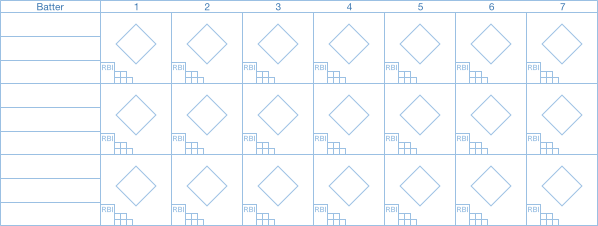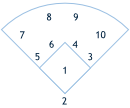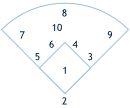How To Keep Score For Softball Games
A quick introduction to the art of softball scorekeeping
SportDoggy lets you keep detailed stats for your team. In order to save these stats, you must have a scorekeeper keep score for your games. A baseball or softball scoresheet can look like Egyptian hieroglyphics at first, but once you learn the notation, keeping score is easy and can be a lot of fun. This guide is written for slow-pitch softball leagues, so stealing bases, getting hit by pitches, and other events are not discussed.
- Sections:
- Introduction
- Basics
- Reaching Base
- Getting Out
- Examples
Introductiontop
Before you get started, you will want to purchase a special notebook with pre-printed scoring boxes. They are available at most sports stores, and will help you remember where things go. They also usually have reminders of how to score common events during a game, as well as the player numbering system.
The basic layout of the scoresheet is this:

Player names are written in the Batter column, in the order that they will be batting. Many sheets have space for multiple batters per row to allow for substitutions. Write one name per row of baseball diamonds. The diamonds are used to record what each batter did for his plate appearance for each inning that he or she bats. Some scoresheets have extra notation to show you where to record RBIs, outs, or balls and strikes, but some will just have the diamond.
The example here has a box for RBIs (labeled RBI), and boxes to check off balls and strikes. The bottom row of 3 boxes is for balls, and the top row of 2 boxes is for strikes. Every time a ball or strike is called, you can put a mark in the appropriate box. This isn't essential, and many scorekeepers don't make marks here. RBIs, on the other hand are important, and will be explained further down.
You will want to create a second sheet with the other team's lineup, so that you can record your team's fielding and pitching stats, which you get by looking at what you recorded while the other team was batting.
Basicstop
Each diamond is where you write what each player did while batting for each inning that he or she bats. There is notation for if the batter gets out, and notation for if they get a hit. Also, you will show how the players progress around the bases. Every time a player reaches a base, you draw a line to that base, going around the diamond just as the player is doing in reality. Multiple players may be running the bases, so you may be updating multiple squares at a time. If a player makes it all the way home, then you fill in the diamond to make it easier to count runs scores at the end of the inning.
If there is a substitution in the middle of the game, where one batter takes the place of another, write the new batter's name in the row underneath the replaced batter's name. You will also want to draw a vertical line on the scoresheet to indicate where the change occurred. This will make sure you enter the correct stats for the correct batter after the game.
Every time a batter steps up to the plate, you write down everything that happens for both the batter and the players already on base. If players advance to a new base, you update their square on the scoresheet. As for the batter, one of two things can happen: they can either get on base, or they get out. This guide will show you what to write down in either case, and then show some complete innings to show how multiple boxes get updated at once. First, let's look at the different ways a batter can get on base.
When the Batter Gets On Basetop
Hopefully (for the batting team), one of the above plays doesn't happen, and the batter makes it on base. But how? There are lots of different ways a batter can get on base. Let's take a look:
Single
 The most basic hit is where the batter runs safely to first. There were no errors on the play, and no attempts to get another runner out.
We note this with 1B, and we draw a line from home to first base on the diamond.
The most basic hit is where the batter runs safely to first. There were no errors on the play, and no attempts to get another runner out.
We note this with 1B, and we draw a line from home to first base on the diamond.
Double
 If the batter makes it to second without any errors or attempts to get another runner out, it's a double, and we write 2B. A line is drawn
from home to first, and then to second to show his progress. We write 2B on the second base line so that we know it was double in case we have
trouble reading our handwriting later.
If the batter makes it to second without any errors or attempts to get another runner out, it's a double, and we write 2B. A line is drawn
from home to first, and then to second to show his progress. We write 2B on the second base line so that we know it was double in case we have
trouble reading our handwriting later.
Triple
 If the batter makes it to second without any errors or attempts to get another runner out, it's a double, and we write 2B. A line is drawn
from home to first, then to second, and finally to third to show his progress.
If the batter makes it to second without any errors or attempts to get another runner out, it's a double, and we write 2B. A line is drawn
from home to first, then to second, and finally to third to show his progress.
Home Run
 If the batter makes it all the way home on his hit, then it's a home run, and we write HR on the third base line. There's always
at least one RBI on a home run (the batter gets credit for himself). There's also always a run scored.
If the batter makes it all the way home on his hit, then it's a home run, and we write HR on the third base line. There's always
at least one RBI on a home run (the batter gets credit for himself). There's also always a run scored.
Walk
 If the pitcher pitches 4 (3 in some leagues) balls, then the batter gets to go to first base automatically. This is called a walk, and we record it
as a BB (Base on Balls). We still draw the line from home to first to show his progress. If the bases are loaded, then someone scores on
the walk, and the batter gets an RBI.
If the pitcher pitches 4 (3 in some leagues) balls, then the batter gets to go to first base automatically. This is called a walk, and we record it
as a BB (Base on Balls). We still draw the line from home to first to show his progress. If the bases are loaded, then someone scores on
the walk, and the batter gets an RBI.
Fielder's Choice
 These can be tricky to score. When a fielde's choice happens, we record it as FC, and draw a line from home to first as usual. A fielder's
choice happens when the fielders choose to attempt to get another runner on base out instead of the batter.
These can be tricky to score. When a fielde's choice happens, we record it as FC, and draw a line from home to first as usual. A fielder's
choice happens when the fielders choose to attempt to get another runner on base out instead of the batter.
Safe on Error
 If a fielder commits an error that allows the batter to make it safely on base, then you draw the path appropriate for where the batter ended up, and
write E along with the position number for who committed the error.
If a fielder commits an error that allows the batter to make it safely on base, then you draw the path appropriate for where the batter ended up, and
write E along with the position number for who committed the error.
Base Runningtop
 After the batter reaches base, you update his progress around the bases as other batters hit. If he reaches home, you color in the diamond to make it
easy to count scored runs later. If a runner gets out running from one base to another, draw a line on the diamond halfway toward the base he was
running to, and cap the line off to show that he didn't make it all the way. Write down the fielding positions of who made the out, and then record
the out in the lower left corner.
After the batter reaches base, you update his progress around the bases as other batters hit. If he reaches home, you color in the diamond to make it
easy to count scored runs later. If a runner gets out running from one base to another, draw a line on the diamond halfway toward the base he was
running to, and cap the line off to show that he didn't make it all the way. Write down the fielding positions of who made the out, and then record
the out in the lower left corner.

RBIstop
RBI stands for Run Batted In. They are earned by the batter when a runner scores as a result of their at bat. If they hit a single and someone else scores, the batter gets an RBI. If the bases are loaded and the batter gets walked, it's an RBI for the batter. Of course, nothing is that simple and there are a few exceptions. It is NOT an RBI if any of the following happens:
- A fielder commits an error that allows a runner to score.
- The batter grounds into a double play.
When the Batter Gets Outtop
To record outs, you write down which position made the out. To keep things simple, each position is numbered from 1 to 10:
- Pitcher
- Catcher
- First Base
- Second Base
- Third Base
- Shortstop
- Left Field
- Left Center
- Right Center
- Right Field
This list corresponds to the picture on the left. Another way to place your outfielders is to have a rover or buckshort that plays shallow, behind the shortstop, while your other outfielders play deeper. In this case, the rover is usually numbered 10.
Whenever an out is made, you write down the position number for everyone who touched the ball to generate the out. For example, if a ground ball is hit to shortstop, and he throws to first base to force the batter out, then you would write down “6-3” in the square for the batter, since the shortstop is number 6, and the first baseman is number 3. It is important to remember that the number corresponds to the player, not the position. If the shortstop ran into the outfield to catch a ball, you would still write down 6 (for shortstop), not 7 (for the left field).
Let's look at all the different ways a batter can be called out:
Strike Out
 If a batter strikes out, either by swinging, or a called 3rd strike, you write a letter K in the batter's box.
If a batter strikes out, either by swinging, or a called 3rd strike, you write a letter K in the batter's box.
Ground Out
 Another way the batter can be out is if the ball is hit on the ground to someone and they throw to someone else to make the out.
Another way the batter can be out is if the ball is hit on the ground to someone and they throw to someone else to make the out.
Fly Out
 If the ball is caught in the air before it hits the ground, then the batter is automatically out. To record this play, you write
the letter F followed by the position number of the player who caught it.
If the ball is caught in the air before it hits the ground, then the batter is automatically out. To record this play, you write
the letter F followed by the position number of the player who caught it.
Sacrifice Fly
 After a fly ball is caught, other runners have the option of running to the next base. If a runner scores after the fly ball is caught,
then it is called a sacrifice fly, and you write down SF instead of F, along with the position number of the person who caught it.
After a fly ball is caught, other runners have the option of running to the next base. If a runner scores after the fly ball is caught,
then it is called a sacrifice fly, and you write down SF instead of F, along with the position number of the person who caught it.
Unassisted Out
 Sometimes the batter will hit the ball to someone on the ground, and they will get the batter out without throwing the ball to anyone.
This called an unassisted out, and is recorded as the position number for who made the out followed by the letter U.
Sometimes the batter will hit the ball to someone on the ground, and they will get the batter out without throwing the ball to anyone.
This called an unassisted out, and is recorded as the position number for who made the out followed by the letter U.
Double Play
 If two people get out on the same play, it is called a double play. If this happens, you write DP, along with the position numbers for
everyone involved in the play. Note that a double play can only happen when there are 0 or 1 outs. The inning ends as soon as the
3rd out is made.
If two people get out on the same play, it is called a double play. If this happens, you write DP, along with the position numbers for
everyone involved in the play. Note that a double play can only happen when there are 0 or 1 outs. The inning ends as soon as the
3rd out is made.
Triple Play
 Similar to a double play, if there are no outs in the inning, 3 people can be put out in the same play. If this happens, write TP in the box
for the batter, and the position numbers for everyone involved in making the out.
Similar to a double play, if there are no outs in the inning, 3 people can be put out in the same play. If this happens, write TP in the box
for the batter, and the position numbers for everyone involved in making the out.
Examplestop
Here are some example innings to show how scoring works over multiple batters.
Example 1

Example 2

Example 3

Example 4

Example 5

Example 6

Still confused? Drop us a line!

